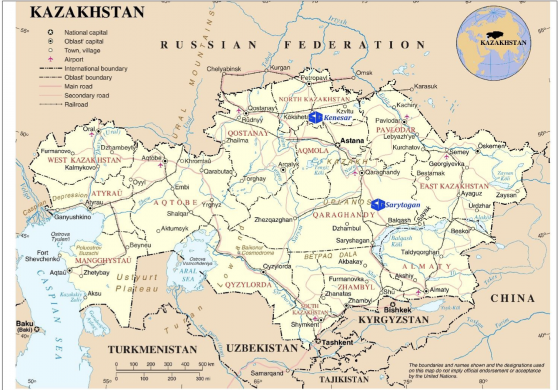Sarytogan Graphite Ltd (ASX:SGA) is looking to expand its graphite footprint in Kazakhstan after a licence was given to 100%-owned subsidiary Ushtogan LLP to explore the Kenesar Graphite Exploration Project in the Akmola Province.
Surrounded by strong infrastructure, including well-developed roads, railways and high-voltage powerlines, the Kenesar area is connected by highway to Kazakhstan’s capital Astana and is just 40 kilometres from regional centre Kokshetau city.
The distance by highway from the company's Sarytogan Graphite Project to the Kenesar Exploration Project is 660 kilometres. The flagship namesake project has an indicated and inferred mineral resource recently estimated by AMC Consultants to total 229 million tonnes at 28.9% TGC.
Kenesar and Sarytogan project Locations.
Sarytogan is pursuing a strategy to supply high-quality anode material for the rapidly growing electric vehicle battery market and Kenesar would fit this strategy nicely.
“Sarytogan’s sustainable competitive advantage is our in-country exploration team’s ability to identify, explore and develop mining projects in Kazakhstan," managing director Sean Gregory said.
"As we move into the studies phase for the giant and premium microcrystalline Sarytogan Graphite Project, our new Kenesar project provides a relatively low-cost opportunity to leverage our future position in the graphite market.”
Kenesar’s geology
Kenesar’s geology consists of Pre-Cambrian strata-formations controlled by NW-striking regional structures of the Kokshetau Shield.
The Pre-Cambrian formations are represented by a variety of regionally metamorphosed rocks: quartz-muscovite schists, gneisses, chlorite-biotite- and garnet-sillimanite schists. The strata-formations are intensively folded and overprinted by predominately NW-trending regional faults.
The strata-bound graphite mineralisation occurs in quartzites and various schists as bands, lenses and disseminated crystals. The extension of the graphite-bearing formations within Kenesar tenement is 30 kilometres by width 3 to 8 kilometres.
Thin section of graphitic schist from Kenesar.
Prospective for graphite mineralisation
Historic mineralogical studies show the concentration of the graphite at Kenesar varies in thin sections from 5% to 25%. Crystals of graphite have also been observed in thin sections of rocks sampled from Kenesar by Sarytogan’s geological team.
The Pre-Cambrian graphitic schists at Kenesar are prospective for graphite mineralisation. In contrast to the Sarytogan Graphite Deposit, which was formed by contact metamorphism, the rocks at Kenesar have been subject to regional metamorphism.
This geology is known to host flake graphite deposits elsewhere globally. Any economic graphite mineralisation discovered at Kenesar could be complementary to the premium micro-crystalline graphite at Sarytogan’s flagship Sarytogan Graphite Deposit.
Drilling and surveys to come
To identify the higher-grade and shallower graphitic mineralisation, Sarytogan has planned an electromagnetic (EM) survey over the Kenasar project.
Exploration drilling is also planned for the highest priority targets identified by the EM survey during the 2023 field season.
Regular exploration results are expected to flow throughout the year.
Read more on Proactive Investors AU
